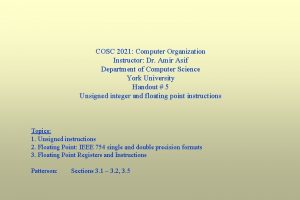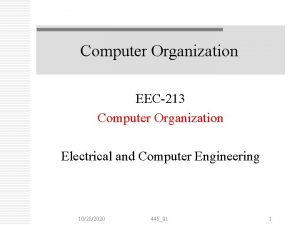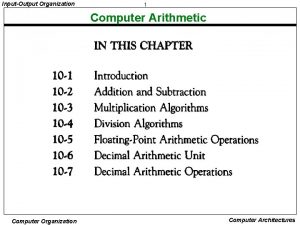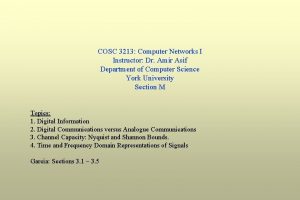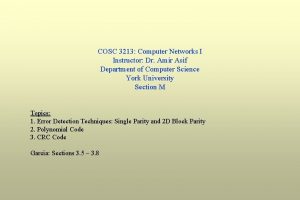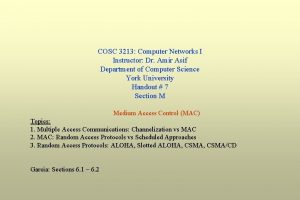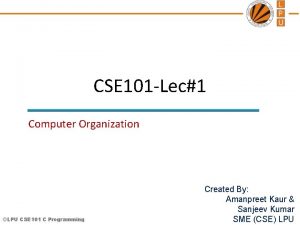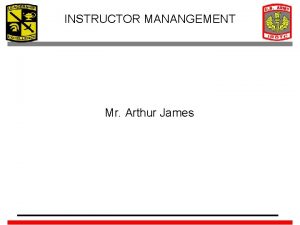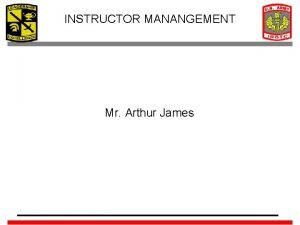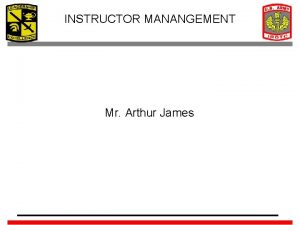CSE 2021 Computer Organization Instructor Dr Amir Asif





















- Slides: 21

CSE 2021: Computer Organization Instructor: Dr. Amir Asif Department of Computer Science York University Handout # 2: Measuring Performance Topics: 1. Performance: Definition 2. Performance Metrics: CPU Execution Time and Throughput 3. Benchmarks: SPEC’ 95 4. Alternative Performance Metrics: MIPS and FLOPS Patterson: Sections 1. 4 – 1. 9.

Analogy with Commercial Airplanes What does it mean do say that one computer is better than another? Passenger Capacity Cruising range (miles) Cruising speed (mph) Passenger throughput (passengers × mph) Boeing 777 375 4630 610 375 × 610 = 228, 750 Boeing 747 470 4150 610 470 × 610 = 286, 700 BAC/Scud Concorde 132 4000 1350 132 × 1350 = 178, 200 Douglas DC-8 -50 146 8720 544 146 × 544 = 79, 424 Airplane — To know which of the four planes exhibits the best performance, we need to define a criteria for measuring “performance”. Performance Criteria: Speed Capacity Range Throughput Winner: BAC/Scud Concorde Boeing 747 Douglas DC-8 -50 Airbus A 3 xx 2

Computer Performance (1) — Performance of a computer is based on the following criteria: 1. Response/Execution Time: Elapsed time between the start and the end of one task. 2. Throughput: Total number of tasks finished in a given interval of time. An IT manager will be interested in having a higher overall throughput while a computer user will like to have a lower execution time for his task. Using execution time as the criteria, the performance of a machine X is defined as — Performance ratio (n) between two machines X and Y is defined as — — 3

Computer Performance (2) Activity 1: If machine X runs a program in 30 seconds and machine Y runs the same program in 45 seconds, how much faster is X than Y? Activity 2: Discuss which of the following two options is suited to enhance performance from a user’s perspective: (a) Upgrading a machine to a faster CPU (b) Adding additional processors to the machine s. t. multiple processors are used for different tasks. Repeat for an IT manager? 4

What is Execution Time (1)? 1. — 2. — — 3. Elapsed Time/Response Time/Wall Clock Time: is defined as the clock time it takes from the start to the end of a program or a task Since computer is a timeshared machine (running several programs simultaneously), the elapsed time will be dependent on the number and complexity of other programs running on the machine. CPU Time: is the execution time that the CPU spends on completing a task CPU time does not include time spent on running other programs or waiting for the I/O to become free. CPU time can be further broken down into: (a) User CPU time: CPU time spent to execute the measured program (b) System CPU time: CPU time spent in the operating system performing tasks on behalf of the measured program Command time in Unix can be used to determine the elapsed time and CPU time for a particular program Syntax: time <name_of_program> Result: 5

What is Execution Time (2)? 4. Performance based on User CPU time is called the CPU performance 5. Performance based on System time is called the system performance 6. Vendors specify the speed of a computer in terms of clock cycles. For example, a 1 GHz Pentium is generally believed to be faster than a 500 MHz Pentium. We define the clock cycles formally next. Multiples defined: 6

Clock (1) Binary 1 Binary 0 1 cycle Leading edge Trailing edge — — All events in a computer are synchronized to the clock signal Clock signal is therefore received by every HW component in a computer Clock cycle time: is defined as the duration of 1 cycle of the clock signal Clock cycle rate: is the inverse of the clock cycle time. — CPU execution time is therefore defined as Clock Signal 7

Clock (2) — Timing Programs generally return the average number of clock cycle needed per instruction (denoted by CPI) Activity 3: For a CPU, instructions from a high-level language are classified in 3 classes Instruction Class A B C CPI for the instruction class 1 2 3 Two SW implementations with the following instruction counts are being considered Instruction counts per instruction class A B C Implementation 1 2 Implementation 2 4 1 1 Which implementation executes the higher number of instructions? Which runs faster? What is the CPI count for each implementation? 8

Performance Comparison (1) To compare performance between two computers, 1. Select a set of programs that represent the workload 2. Run these programs on each computer 3. Compare the average execution time of each computer 4. At time the geometric mean is used. Activity 4: Based on the arithmetic and geometric means execution time, which of the two computer is faster? Execution Time Computer A Computer B Program 1 2 10 Program 2 100 105 Program 3 1000 100 Program 4 25 75 9

Performance Comparison: Benchmarks (2) — Benchmarks: are standard programs chosen to compare performance between different computers. — Benchmarks are generally chosen from the applications that a user would typically use the computer to execute. — Benchmarks can be classified in three categories: 1. Real applications reflecting the expected workload, e. g. , multimedia, computer visualization, database, or macromedia director applications 2. Small benchmarks are specialized code segments with a mixture of different types of instructions 3. Benchmark suites containing a standard set of real programs and applications. A commonly used suite is SPEC (System Performance Evaluation Cooperative) with different versions available, e. g. , SPEC 89, SPEC’ 92, SPEC’ 95, SPEChpc 96, SPEC CPU 2006 and SPECINTC 2006 suites. 10

Performance Comparison: SPEC Suite (2) — SPEC’ 95 suite has a total of 18 programs (integer and floating point). However, SPEC CPU 2000 has a total of 32 programs — SPEC ratio for a program is defined as the ratio of the execution time of the program on a Sun Ultra 5/10(300 MHz processor) to the execution time on the measured machine. — CINT 2000 is the geometric mean of the SPEC ratios obtained from the integer programs. The geometric mean is defined as — CFP 2000 is the geometric mean of the SPEC ratios from the floating-point programs Activity 5: Complete the following table to predict the performance of machines A and B Time on A (seconds) Time on B (seconds) Program 1 5 25 Program 2 125 25 Normalized to A A B Normalized to B Arithmetic Mean Geometric Mean 11

Performance Comparison: CINT 2006 for Opteron X 4 2356 (3) Name Description Instruct. Count × 109 CPI Clock Cycle time (ns) Exec time (s) Reference time (s) SPECratio = Ref. time / Ex. time perl Interpreted string processing 2, 118 0. 75 0. 40 637 9, 777 15. 3 bzip 2 Block-sorting compression 2, 389 0. 85 0. 40 817 9, 650 11. 8 gcc GNU C Compiler 1, 050 1. 72 0. 47 24 8, 050 11. 1 mcf Combinatorial optimization 336 10. 00 0. 40 1, 345 9, 120 6. 8 go Go game (AI) 1, 658 1. 09 0. 40 721 10, 490 14. 6 hmmer Search gene sequence 2, 783 0. 80 0. 40 890 9, 330 10. 5 sjeng Chess game (AI) 2, 176 0. 96 0. 48 37 12, 100 14. 5 libquantum Quantum computer simulation 1, 623 1. 61 0. 40 1, 047 20, 720 19. 8 h 264 avc Video compression 3, 102 0. 80 0. 40 993 22, 130 22. 3 omnetpp Discrete event simulation 587 2. 94 0. 40 690 6, 250 9. 1 astar Games/path finding 1, 082 1. 79 0. 40 773 7, 020 9. 1 xalancbmk XML parsing 1, 058 2. 70 0. 40 1, 143 6, 900 6. 0 Geometric mean 11. 7 High cache miss rates 12

Improving Performance of a CPU can be improved by: 1. Increasing the clock rate (decreasing the clock cycle time) 2. Enhancements in the Compiler to decrease the instruction count in a program 3. Improvement in the CPU to decrease the clock cycle per instruction (CPI) Unfortunately factors (1 – 3) are not independent. For example, if you increase the clock frequency then the CPI may also increase. 13

Power Trends (1) — One way of enhancing performance is to increase clock rate (implying a reduction in clock cycle time). — A consequence of increasing clock rate is an increase in power dissipation. 14

Power Trends (2) — Dynamic power dissipation is computed from the expression — In the previous figure, note that when clock rates have increased by a factor of 1000 (25 to 2667), the power dissipation only increased by a factor of 20 (4. 9 to 95). — The above is largely a consequence of the operating voltage in CMOS technology going down from 5 V to 1 V. Activity: What is the impact on dynamic power dissipation if a new processor reduces the capacitive load, voltage, and clock frequency all by a factor of 15%? 15

Uniprocessor Performance Constrained by power, instruction-level parallelism, memory latency 16

SPEC Power Benchmark — SPECpower reports power consumption of servers at different workloads, divided by 10% increments, over a period of time. Target Load % Perform. (ssj_ops/sec) 100% 231, 867 295 90% 211, 282 286 80% 185, 803 275 70% 163, 427 265 60% 140, 160 256 50% 118, 324 246 40% 920, 35 233 30% 70, 500 222 20% 47, 126 206 10% 23, 066 180 0% 0 141 1, 283, 590 2, 605 Overall sum ∑ssj_ops/ ∑power Average Power (Watts) 493 17

PITFALL: Amdahl’s Law (1) Ø Improving an aspect of a computer and expecting a proportional improvement in overall performance Ø Suppose a program runs in 100 s on a computer with multiply operations responsible for 80% of the time. How much should the speed of multiplication be improved to make the program run twice faster? Five times faster? Solution: For 2 times faster, the speed of multiplication should be improved by a factor of 8/3. Five times faster is not possible. 18

PITFALL: MIPS as a Performance Metric (2) Do not use MIPS (million instructions per second) as a performance metric Activity 6: For a CPU, instructions from a high-level language are classified in 3 classes Instruction Class A B C CPI for the instruction class 1 2 3 Two SW implementations with the following instruction counts are being considered Instruction counts (in billions) for each instruction class A B C Implementation 1 5 1 1 Implementation 2 10 1 1 Assuming that the clock rate is 500 MHz, which code sequence will be run faster based on (a) MIPS and (b) execution time. 19

PITFALLS: Do Not’s (3) 4. Do not use MFLOPS (Million Floating point operations per second) as a performance metric 5. Do not use PEAK Performance as a performance metric Example: I 860: @50 MHz: 100 MFLOPS and 150 MOPS MIPS @R 3000: 16 MFLOPS and 33 MOPS Running SPEC benchmarks, R 3000 was 15% faster in execution time based on the geometric mean 20

PITFALLS: Do Not’s (4) 4. 5. Do not use synthetic benchmarks (vendor created) to predict performance — Commonly used synthetic benchmarks are Whetstone and Dhrystone — Whetstone was based on Algol in an engineering environment and later converted to Fortran — Dhrystone was written in Ada for systems programming environments and later converted to C — Such synthetic benchmarks do not reflect the applications typically run by a user Do not use the arithmetic mean of execution time to predict performance. Geometric means provide better estimates. 21
 Amir asif
Amir asif Minahil asif
Minahil asif Ltad evreleri
Ltad evreleri Barrel chest
Barrel chest Sutura pds
Sutura pds Asif international
Asif international Asif əsgərov
Asif əsgərov Process organization in computer organization
Process organization in computer organization Basic structure of a computer system
Basic structure of a computer system Computer architecture and organisation
Computer architecture and organisation Interrupt cycle flow chart
Interrupt cycle flow chart Basic computer design
Basic computer design Point by point arrangement
Point by point arrangement Participante contreras
Participante contreras Basic instructor course tcole
Basic instructor course tcole Basic instructor course texas
Basic instructor course texas Basic instructor course tcole
Basic instructor course tcole Pepperball launcher nomenclature
Pepperball launcher nomenclature Not only the students but also the instructor
Not only the students but also the instructor Instructor vs teacher
Instructor vs teacher Cisco certified trainer
Cisco certified trainer Mptc firearms
Mptc firearms























